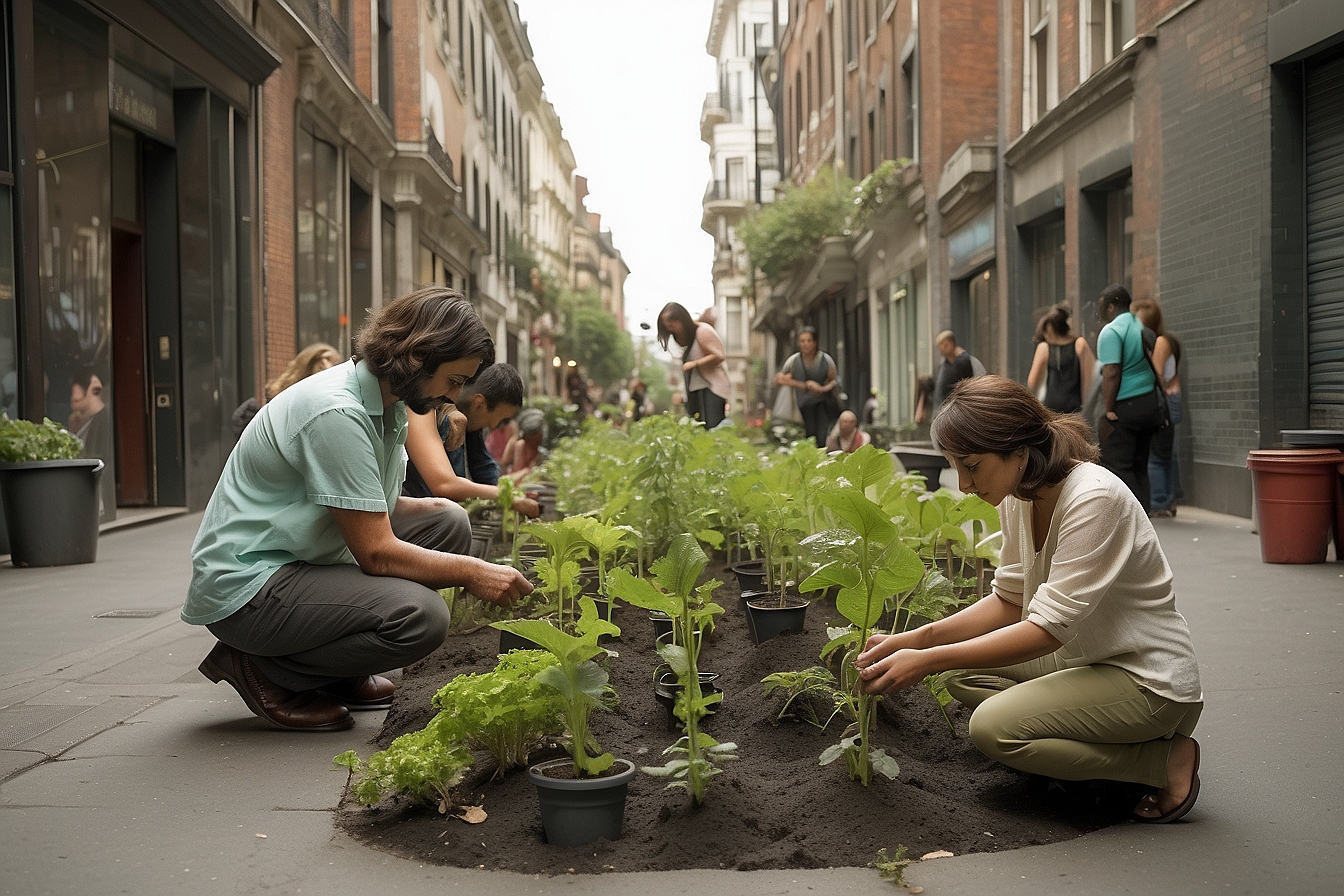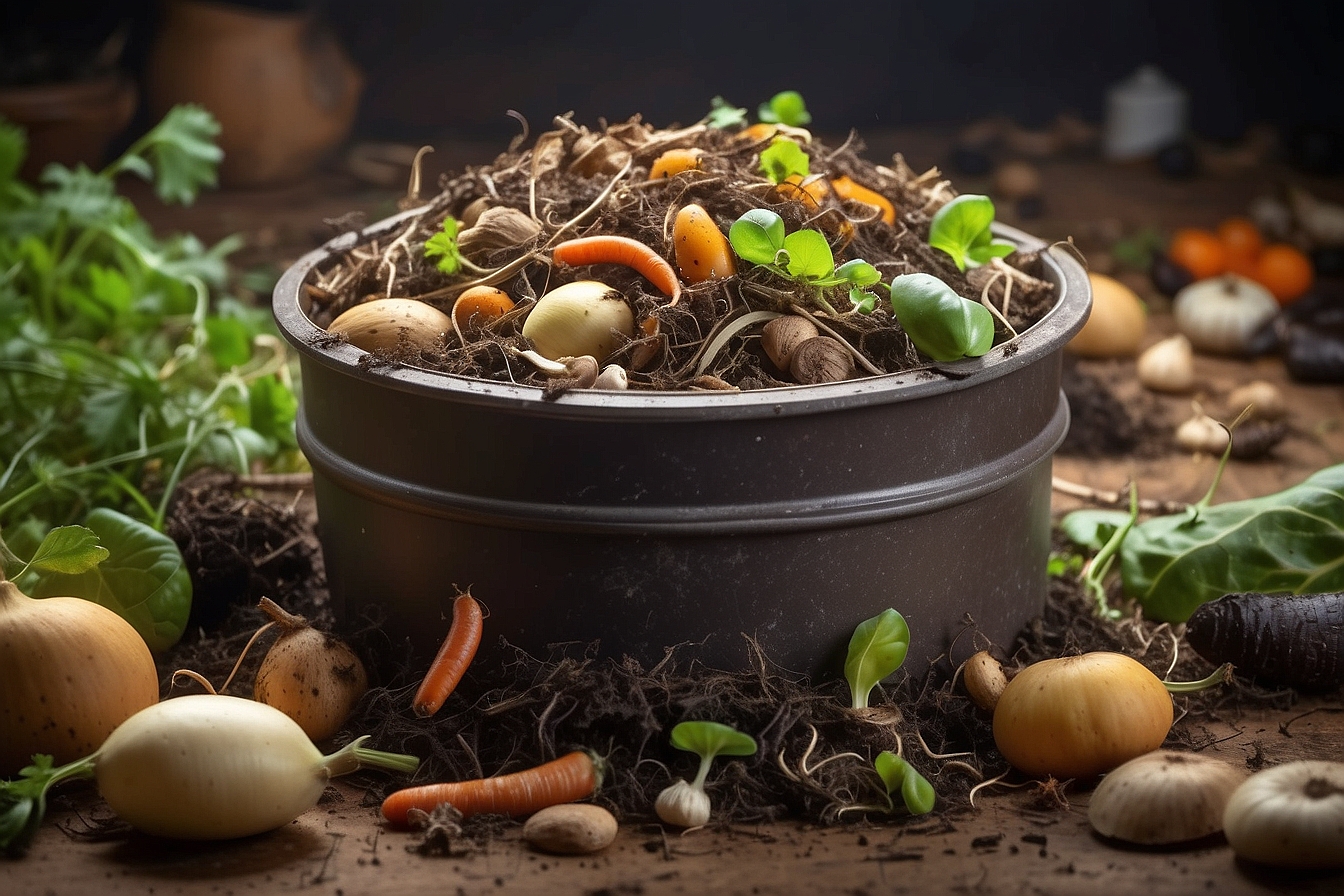Maximising space and enriching the soil in our gardens can often feel like a complex conundrum that stubbornly refuses to be cracked. We understand the entanglement all too well, having navigated through the trial and error involved in nurturing a vegetable patch into full bloom.
But did you hear about nature’s own little secret? There are certain plants that, when sown side by side, can be wonderfully beneficial to one another. Our guide aims to shed light on the fine art of companion planting—revealing which plant pairings will turn your veggie plot into a flourishing sanctuary.
Delve into this read for insider tips on cultivating the perfect symbiotic relationships within your garden beds.
Key Takeaways
- Companion planting involves strategically placing different crops together to benefit each other, helping with growth, soil health, and pest control.
- Key plant combinations include tomatoes with basil or marigolds for pest deterrence and flavour enhancement, beans with corn for mutual support, and marigolds near squash to repel pests.
- Using flowers like nasturtiums and herbs such as dill in the garden attracts beneficial insects while deterring pests without harmful chemicals.
- Avoid common mistakes in companion planting by researching plants’ requirements beforehand and ensuring they have adequate space to thrive alongside their companions.
- For successful companion gardening, consider suitable plant pairings based on their needs, practice good soil health maintenance, and observe proper timing for sowing seeds.
What is Companion Planting?
Companion planting is the practice of growing different plants together in a way that they benefit each other. It involves planting two or more plant species close to each other to create an ecosystem that supports and enhances the growth of all plants involved.
Definition
Companion planting is the strategic placement of different crops close to each other to enhance growth, soil health, and pest management. We harness the natural friendships between certain plants to boost our vegetable gardens.
This method taps into biodiversity and encourages a more sustainable form of agriculture. By understanding plant associations and their mutual benefits, we can create a garden layout that optimises nutrient uptake, maximises garden space efficiency, and improves crop protection.
We focus on creating beneficial plant arrangements that support a thriving ecosystem in your back garden. Intercropping comes into play here; it’s about growing two or more crops near one another for direct benefit—like how some plants can ward off insects naturally or attract pollinators needed for productive gardens.
Planting combinations are chosen with care to ensure they work together rather than compete for resources. Following these methods leads us towards gardening benefits like better resilience against weather changes whilst fostering environmental conservation.
Now let’s delve into the purpose behind this approach.
Purpose
Having clarified the concept of companion planting, it is essential to understand its purpose in vegetable gardening. The primary goal of companion planting is to promote a healthy and sustainable garden ecosystem by leveraging the natural associations between certain plants.
This practice aims to create mutually beneficial relationships between different plant species, enhancing their growth, deterring pests, and increasing overall yield. Furthermore, employing companion planting techniques fosters biodiversity in the garden and supports environmentally friendly agricultural practices.
Incorporating companion planting into your vegetable garden layout can significantly contribute to conserving soil nutrients, protecting against harmful insects, and encouraging pollination for improved crop production.
Benefits of Companion Planting
Companion planting offers several benefits to your vegetable garden. It helps save space by allowing plants to grow together harmoniously, improves soil health through mutual support and nutrient exchange, and can help manage insect pests naturally, reducing the need for harmful chemical pesticides.
Saving space
When planting our vegetable garden, we maximise space by pairing tall crops like corn with low-growing ones such as lettuce. This method optimises the use of limited garden areas while promoting efficient growth.
We can also train vining plants to grow vertically, freeing up ground space for other vegetables. For example, we can grow cucumbers on a trellis instead of allowing them to spread across the ground.
This not only saves space but also helps improve air circulation around the plants.
Improving soil health
To improve soil health, we mix compatible plants to balance the nutrients in the ground. This creates a diverse environment that benefits the soil and supports plant growth. By planting certain combinations of vegetables, legumes, and herbs together, we can help increase organic matter in the soil, reduce erosion, and enhance its overall structure.
Mixing different types of plants also helps prevent pest infestation and diseases while promoting beneficial microbial activity. It’s important to choose companion plants wisely: for example, pairing nitrogen-fixing legumes with heavy feeders like tomatoes will enhance soil fertility naturally without relying on synthetic fertilisers or harmful chemicals.
Providing mutual support
When planting a vegetable garden, it’s essential to consider how different plants can support each other. Some plants release natural substances into the soil that benefit their neighbouring crops, while others help deter pests or attract beneficial insects.
For example, planting beans alongside corn can contribute nitrogen to the soil, which boosts the corn’s growth. Likewise, interplanting aromatic herbs like basil among tomatoes can confuse and repel pests away from the tomato plants.
Additionally, pairing tall-growing sunflowers with climbing vines like peas provides structural support for the legumes while simultaneously offering shade and wind protection for delicate crops below.
Managing insects
When ensuring mutual support between plants in your vegetable garden, managing insects is a crucial aspect of maintaining a healthy ecosystem. Introducing companion plants such as marigolds, chives, or nasturtiums alongside your vegetables can help deter pests.
These companion plants release natural chemicals that repel harmful insects and attract beneficial ones, creating a balanced environment in your garden. Additionally, planting herbs like basil and mint can act as natural insect repellents while also offering culinary benefits.
To further manage insects, consider incorporating diverse plant species to disrupt potential pest habitats and reduce the risk of infestations. This approach not only minimises the need for chemical pesticides but also encourages biodiversity within your garden—a key factor in promoting overall environmental health.
Best Companion Plants for Common Vegetables
Planting tomatoes with basil or marigolds can help to repel insects and improve the flavour of the tomatoes.
Find out more about how companion planting can benefit your vegetable garden in our blog!
Tomatoes
When planting tomatoes, consider companion plants such as basil, chives, and onions. These plants help to deter pests like aphids and hornworms while enhancing the flavor of your tomatoes.
Additionally, marigolds are excellent companions for tomatoes as they repel nematodes in the soil.
To support tomato growth in your vegetable garden, interplant with herbs and flowers like nasturtiums or borage that attract beneficial insects. The aromatic compounds emitted from these companion plants can confuse pests searching for their preferred host plant.
Potatoes
When planting potatoes, consider companion plants that can enhance their growth. For example, beans and peas are beneficial companions as they fix nitrogen in the soil, providing essential nutrients to the potatoes.
Additionally, horseradish is known to repel potato bugs and can be planted alongside potatoes for natural pest management.
Potatoes also pair well with corn and marigolds. Corn provides a natural support structure for potato vines while marigolds deter pests such as nematodes. Interplanting these vegetables creates a diverse garden ecosystem that promotes healthy growth and reduces the need for chemical interventions.
Peppers
When planting peppers in your vegetable garden, consider companion plants such as basil and onions. These companions can help deter pests that commonly affect pepper plants, ensuring a healthier crop.
Additionally, marigolds planted alongside peppers can also repel harmful insects due to their natural pest-repelling properties.
Planting guide
Beans
When considering companion planting in your vegetable garden, beans are an excellent choice to grow alongside other vegetables. Beans are known for their ability to enrich the soil with nitrogen, making them ideal companions for plants like tomatoes and squash.
Additionally, their vining nature can provide natural shade for low-growing crops while helping to suppress weeds. When strategically planted among other vegetables, beans offer a range of benefits that contribute to a healthier and more productive garden.
Incorporating beans into your companion planting strategy not only promotes biodiversity but also enhances the overall resilience of your garden ecosystem. By harnessing the natural synergies between beans and other vegetables, you can create a thriving environment that supports conservation efforts and sustainable gardening practices.
Squash
When considering companion planting for squash, it’s important to choose plants that can assist in repelling pests and encouraging growth. For instance, planting marigolds alongside squash can help deter nematodes and other harmful insects due to their natural pest-repelling properties.
Additionally, consider integrating nitrogen-fixing legumes such as beans or peas into the same garden area, as they can enrich the soil with essential nutrients needed for healthy squash development.
Furthermore, pairing squash with aromatic herbs like thyme or mint can help confuse and repel pests due to their strong scents. These companion plantings not only promote a healthier ecosystem but also contribute to more robust and bountiful harvests in your vegetable garden.
Tips for Successful Companion Planting
Utilise flowers as companions, create insect-attracting habitats, and avoid common mistakes for a successful companion planting. For more in-depth information on how to make your vegetable garden thrive through companion planting, keep reading!
Using flowers as companions
Planting flowers alongside your vegetables can help attract beneficial insects, such as bees and ladybugs, to your garden. These pollinators are crucial for the reproduction of many vegetable plants and can also help control unwanted pests naturally.
Marigolds, for example, not only add a pop of color but also repel nematodes that can damage plant roots. Additionally, planting nasturtiums near squash or cucumber plants can deter aphids due to their pungent scent.
Integrating flowers into your vegetable garden not only creates a beautiful aesthetic but also contributes to a healthier ecosystem overall. The presence of diverse flora encourages biodiversity and strengthens the resilience of your garden against pests and diseases, promoting a more sustainable approach to gardening.
Creating insect-attracting habitats
To attract beneficial insects to our garden, we can plant a variety of flowers known for their ability to draw in pollinators and pest predators. Flowers like marigolds, lavender, and sunflowers are excellent choices for creating insect-attracting habitats.
These plants not only beautify the garden but also provide nectar and pollen for bees, butterflies, and other helpful insects essential for crop pollination. By incorporating these flowering plants into our vegetable garden, we can promote biodiversity while naturally managing pests without relying on harmful chemicals.
In addition to utilising flowering plants, we can also incorporate herbs such as dill, fennel, and coriander that attract predatory insects like ladybirds and lacewings. These natural predators play a crucial role in controlling aphids and other destructive pests that could harm our crops.
Avoiding common mistakes
When planning companion planting, it’s essential to research the specific needs and characteristics of each plant. Neglecting to consider factors like sunlight requirements, soil preferences, or growth habits can lead to unsuccessful pairings.
Additionally, failing to rotate crops annually may deplete the soil of specific nutrients while promoting disease and pest issues. It’s crucial to avoid overcrowding your plants as this hinders air circulation and sunlight exposure, impacting their overall health.
To attract beneficial insects without unintended consequences such as attracting pests, be vigilant about flower selections within your garden space. Furthermore, overlooking potential allelopathic effects between certain plants can inhibit growth and success.
How to Plan and Plant a Companion Garden
To plan and plant a successful companion garden, choose suitable plant combinations that support each other’s growth. Consider the time of planting to ensure optimal growth and maintain a healthy garden by practicing good soil health and pest management techniques.
Choosing suitable plant combinations
When selecting plant combinations for your companion garden, consider the unique needs of each vegetable. For example, pairing tomatoes with basil can enhance the flavour of both plants and help to deter pests.
Similarly, planting carrots alongside onions can help protect against certain insects. Additionally, take into account the growth habits and space requirements of each plant to ensure they complement each other without competing for resources.
It’s important to research which plants work well together based on their nutrient needs, growth patterns, and pest-repelling properties. This will not only maximise space but also contribute to a healthier garden overall.
As you plan your companion garden, keep in mind that different plants have specific environmental preferences. Matching compatible vegetables based on weather resilience can lead to a more harmonious and successful garden.
Time of planting
When planning and planting a companion garden, timing is crucial. It’s essential to consider the growth rates of different plants and how they will interact over time. Some vegetables may mature quickly, while others take longer to reach their full size.
By understanding the growth patterns of your chosen crops, you can optimise your garden by staggering planting times for better space utilisation and continuous harvests.
Careful consideration of the time of planting allows for a well-balanced ecosystem within your vegetable garden. Planting in phases ensures that each crop receives adequate sunlight, water, and nutrients without overcrowding or competing with one another for resources.
Maintaining a healthy garden
To maintain a healthy garden, we regularly monitor plant health and soil conditions. We keep an eye out for signs of pest or disease infestations and take prompt action to address any issues.
Additionally, we practise crop rotation to prevent depletion of nutrients in the soil and ensure that plants receive the necessary nourishment.
We also make sure to provide adequate water and sunlight to our plants, promoting their overall well-being. Regular weeding helps control unwanted growth and prevent competition for essential resources such as water and nutrients.
Conclusion
In conclusion, companion planting offers multiple benefits for your vegetable garden. It not only saves space but also improves soil health and manages insect problems naturally. By planning and planting a companion garden strategically, you can ensure a healthy and thriving ecosystem in your backyard.
So why not start implementing these simple techniques to enrich your gardening experience?.
FAQs
1. What is companion planting in a vegetable garden?
Companion planting in a vegetable garden involves strategically placing different plants together to benefit each other, improving growth and deterring pests.
2. Can you give me a simple guide on how to do companion planting?
Sure, start by choosing plants that are known good companions and refer to a companion planting guide which outlines which vegetables grow well together for a thriving garden.
3. How does companion planting fit with permaculture practices?
Companion planting aligns perfectly with permaculture by enhancing biodiversity, promoting natural pest control, and creating sustainable ecosystems within your garden.
4. Will my vegetables grow better if I use the companion planting method?
Absolutely! By using the right plant combinations based on an accurate pairing guide, your vegetables can enjoy benefits like improved health and more vibrant growth thanks to companion planting.





